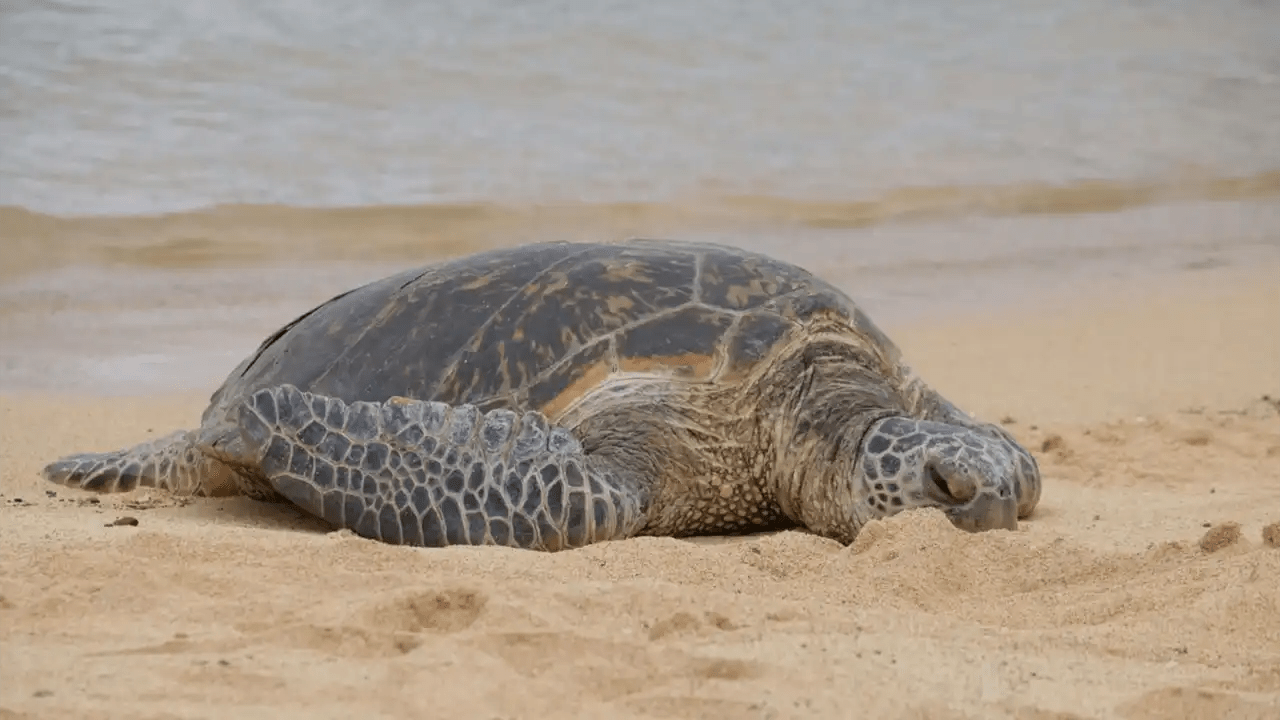What To Know About Hawaiian Green Sea Turtles

When you spend a lot of time on Kauai’s waters like I have, you get to know the rhythms of the ocean, the swells, the seabirds, the dolphins, and, of course, the honu. That’s our Hawaiian green sea turtle, one of the most iconic creatures in the islands.
As the general manager and a captain with Kauai Sea Tours, I’ve seen firsthand how exciting these turtle encounters are for visitors. It’s common for the turtles to be the highlight of the trip for some of our passengers!
And I don’t blame them; these animals are extraordinary. However, to truly appreciate them, it is helpful to understand their story, their cultural significance, and the care they require from all of us so we can keep them safe and healthy.
Hawaiian Green Sea Turtle: Key Information
The Hawaiian green sea turtle (Chelonia mydas), locally known as the honu, is the largest hard-shelled sea turtle in the world and the most common turtle species found in Hawaiian waters.
- Physical Characteristics: Adults typically measure 3–4 feet in length and weigh between 250 and 350 pounds, though some can exceed 400 pounds. Their shells are oval-shaped with colors ranging from dark brown to olive, often patterned with lighter streaks or spots. Despite their name, the turtles are not green on the outside — the term comes from the greenish color of their body fat caused by their algae-rich diet.
- Diet: Juvenile honu are omnivores, feeding on a variety of invertebrates, including jellyfish and crustaceans. However, as they mature, they shift to a primarily herbivorous diet of algae and seagrasses. This grazing helps maintain a balance and keep reef ecosystems healthy.
- Lifespan: Green sea turtles are long-lived animals, with lifespans commonly reaching 60–80 years, and some individuals potentially surviving even longer.
- Behavior: They are strong swimmers capable of traveling long distances, but are also known for basking on beaches in Hawaii — a behavior rare among other sea turtle populations.
- Distribution: While green sea turtles are found in tropical and subtropical seas worldwide, the Hawaiian population is distinct and spends most of its life in the central Hawaiian Islands. Females migrate to the Northwestern Hawaiian Islands, especially French Frigate Shoals, to nest.
The honu play a vital ecological role as reef grazers, a cultural role as symbols of wisdom and protection, and a conservation role as one of Hawaii’s greatest success stories under environmental protection laws.
A Sacred Role in Hawaiian Culture
The honu’s presence in Hawaii is far more than biological. For Native Hawaiians, turtles have long symbolized navigation, wisdom, and protection. Petroglyphs carved into stone hundreds of years ago depict turtles, reflecting their spiritual role.
In Hawaiian legend, the honu is said to act as an aumakua (family guardian spirit), guiding voyagers safely across the sea. Even today, many locals see the appearance of a turtle as a blessing.
When I’m piloting one of our boats and a turtle pops up beside us, I feel that same sense of guidance. Out here, the honu remind us to move with patience and respect — a lesson worth carrying beyond the ocean.
Where to See Turtles on Kauai
Kauai offers some of the best opportunities to see honu in their natural habitat. While they can appear anywhere, these spots are known for frequent sightings:
Poipu Beach
A favorite for visitors and locals, Poipu is one of the most reliable places to see turtles basking on the sand. They often look like smooth boulders until you realize one just took a breath. Poipu Beach is also an excellent beach for swimming!
Lawai Beach
Just west of Poipu, Lawai’s reef is a feeding ground where turtles graze on limu. Snorkelers often share the water with them here.
Nā Pali Coast
On our tours, honu sometimes cruise near the surface around sea caves or remote coves of the Na Pali Coast. With the cliffs rising 3,000 feet above, the scene feels almost cinematic.
Tunnels Beach (Makua)
This north shore spot features a reef system where honu (green sea turtles) feed and rest, making it a popular destination for snorkeling.
Wherever you spot them, remember — turtles choose when and where to appear. That unpredictability makes every encounter feel special. Tunnels Beach is also just a great beach to visit in general!
Why Turtles Bask on Beaches
One of the behaviors that surprises visitors most is basking. Hawaiian green sea turtles are unique among sea turtles for their habit of hauling out onto beaches to rest in the sun.
Scientists believe this helps regulate body temperature and reduces energy spent staying buoyant in the water. For us locals, seeing honu stretched out in the sand is just part of daily island life. For visitors, it’s often an unforgettable moment.
Turtle Etiquette: Sharing Space With the Honu
Because honu are federally protected, there are essential rules to follow when you encounter them:
- Stay at least 10 feet away, both in water and on land.
- Never touch, feed, or chase them.
- Don’t block their path to the ocean or breathing space at the surface.
- Enjoy basking turtles from a distance — never crowd around them for photos.
On our tours, we make sure guests understand these guidelines. A respectful encounter is safer for the turtle — and ultimately more rewarding for you.
The Life Cycle of Hawaiian Green Sea Turtles
The honu’s life journey is nothing short of remarkable:
- Hatchlings: After about two months in the sand, baby turtles emerge at night and make a mad dash to the sea, dodging predators every step.
- The Lost Years: Juveniles drift in ocean currents, feeding in open waters for several years.
- Returning Home: Eventually, they settle into nearshore habitats, such as reefs and lagoons.
- Nesting Migration: Mature females travel up to 1,000 miles to the Northwestern Hawaiian Islands to nest. Males never leave Hawaii’s main islands.
When you see a honu gliding through Kauai’s reefs, you’re looking at the result of one of the toughest survival stories in nature.
Conservation: Success and Ongoing Challenges
The honu’s recovery is one of Hawaii’s most significant conservation victories. By the 1970s, turtle numbers had plummeted due to hunting and habitat destruction. After being listed under the Endangered Species Act in 1978, populations slowly rebounded.
Today, it’s common to see multiple turtles in a single outing — something my parents’ generation never imagined. But challenges remain:
- Fibropapillomatosis (FP): A viral disease that causes tumor growth, affecting turtles’ ability to swim, feed, and see.
- Marine Debris: Fishing line, nets, and plastic bags can entangle or choke turtles.
- Climate Change: Rising sea levels and warming sands threaten nesting grounds.
- Human Pressure: Increased coastal activity can disturb basking and feeding behaviors.
As someone who knows Kauai in and out, we all share responsibility for protecting honu. This means supporting cleanup efforts, adhering to regulations, and educating visitors on how to interact responsibly.
FAQs About Hawaiian Green Sea Turtles
- What is the best time to see turtles in Hawaii?
Nesting season for Hawaiian green sea turtles typically runs from mid-April through October, and in some cases into December. The best time of day to see turtles coming ashore to nest is during the quieter hours of early morning or evening, when beaches are less crowded and conditions are calmer. - Are Hawaiian green sea turtles endangered?
They’re currently listed as “threatened.” Populations have grown, but they remain vulnerable to disease, marine debris, and habitat loss. - Why do turtles bask on the beach?
Unique among sea turtles, Hawaiian green turtles often rest on sand to regulate body temperature and conserve energy. - Can you swim with turtles in Kauai?
Yes, but keep a 10-foot distance and never attempt to touch or feed them. Respectful encounters make the experience better for both you and the turtle. - How long do Hawaiian green sea turtles live?
Most live between 60 and 80 years, although some may surpass this age. - What should I do if I see an injured turtle?
Call the NOAA Marine Wildlife Hotline at 1-888-256-9840[Click to call]. Don’t attempt to move or treat the turtle yourself. - Are there different types of turtles in Hawaii?
Hawaiian waters are home to five of the world’s seven sea turtle species: the green sea turtle (honu), hawksbill (honu‘ea), leatherback, loggerhead, and olive ridley. Of these, the green sea turtle is by far the most frequently seen on local reefs, with the hawksbill being the next most common.
The Hawaiian Green Sea Turtle and Kauai’s Ocean
At Kauai Sea Tours, we believe our job is more than just showing you the Nā Pali Coast and Kauai. It’s about connecting you with the ocean in a way that leaves a lasting impact. Seeing a honu in the wild is one of those moments that changes how you think about the sea.
When you spot a turtle, whether it’s gliding beside your boat or basking on Poipu’s sand, take a moment to appreciate it. You’re witnessing centuries of resilience, culture, and survival. That’s the gift the honu gives to all of us here in Hawaii.
And if you join us on the water, maybe you’ll be lucky enough to make that connection yourself. It’s an experience that stays with you long after you’ve left the island. Don’t miss your chance to see one of Hawaii’s most beloved marine animals – book a snorkeling tour today!

Darren Paskal – General Manager
A dedicated steward of Kauai Sea Tours and a member of the founding family, Darren Paskal has led the company with passion and innovation for nearly a decade. With a sharp focus on customer experience, he’s been instrumental in expanding the Kauai Sea Tours fleet by introducing the first express tour of the Nā Pali Coast, and designing the region’s first luxury tour boat. Darren blends engineering expertise with a deep love for Kauai’s coastline, continually shaping unforgettable ocean adventures for guests from around the world.

